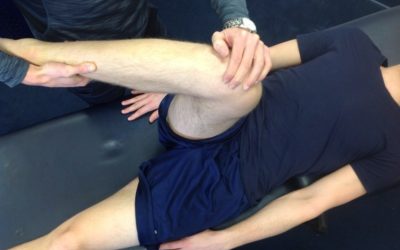Hockey and Yoga, should we combine them?
The practice of yoga has been gaining popularity in North America since the beginning of the century. In 2005, there were more than 1.4 million people who
Physical benefits?
Yoga seems to have a lot of physical benefits in a healthy population. In general, we see improvements in deadlift strength, balance (17), and also increase of mobility in the lumbar region, the neck, the hips, the shoulders and the knees (8,12). It appears that the increase of strength in the forearms is common and depends on the pose performed. A higher proportion of the pose where there is weight bearing on the hands will lead to an increase in grip strength (5,6,12). A review by Abel & al. 2013, observed an increase in overall pulmonary function following yoga practice in a healthy population (3,11).
What about hockey players?
Usually, hockey players are in better shape than the rest of the population and that’s a reason why we have to be cautious interpreting the earlier results. Improvement in strength might not be as high as we can expect in the regular population. For hockey players, we might see more change in type 1 muscle fibres. These slow twitch muscle fibres are used predominantly in endurance activity. Hockey player’s performance is more dependent on the fast twitch fibres that should be trained in specific ways to improve performances.
The majority of hockey players benefit more from the increase in balance and mobility than strength. The room for enhancement of the pulmonary function is smaller than the general population. Since the positive changes are very dependent on the initial function, there is a smaller possibility of improvement for hockey players (11). Since breathing exercises from yoga practice are different than the exercise found in conventional training programs, we believe it will bring a positive change for them even though these changes are modest if present.
Psychological benefit
The word yoga means «union». One goal of yoga is to combine physical, psychological and spiritual sphere (3, 14). It would help reduce anxiety, depression, stress, insomnia and improve mood (8, 14). The increase in melatonin and the activation of the parasympathetic system combined with the diminution of cortisol are mechanisms that could explain these positive changes (3, 15). The state of mind during yoga practice and the focus on breathing alone could help the overall well-being. Practicing yoga at stressful moments in life can help with coping when faced with difficult times.
Risk of injury
Yoga is not without risk. To make sure it is safe, it is recommended to respect one’s limits and progressively try poses that are comfortable. Supervised sessions by certified coaches
What frequency?
It is difficult to determine the duration, frequency, intensity and the style of yoga that is best. There are numerous factors to consider such has periodization of training, individual preferences, resources and the time available. The summer is a good time to increase the number of training sessions. Improvement of posture and increase in training volume without an increase in the risk of injury is seen in speed skaters who incorporated yoga in the off-season (16). For hockey players, it’s beneficial to do one to three yoga sessions per week during the offseason. Before training camp or major competitions, overall training should focus more on sport specific exercises. However, these sport specific exercises can be stressful and practising yoga may assist with the difficult situations. This is why it seems important to have a short daily routine and/or two to four yoga sessions a month during the season.
Conclusion
Finally, without being specific to hockey training, yoga is an activity that can be part of a physical and mental preparation program for players. A small volume of yoga won’t bring about the positive physical changes it proposes. Moreover, the positive changes stated earlier are not exclusive to yoga and can be achieved with alternate training. However, yoga can be a good complement to training. It’s also a good way to expand hockey player’s range of physical and psychological skills.
Written by Maxime Provencher, M. Physiotherapy
Physiotherapist at la clinique due Peps de l’Université Laval
Yogathérapie médicale training with Diana Perez and Lucie Vachon
Photo Credit
Inspiring yoga people:
Carmen Anna Hanggi – Instagram
Here are some places in your area where you can practice yoga:
Alma:
Namasté Studio de yoga Site web
Chicoutimi:
Région de Québec:
Namaste Yoga Limoilou Site web
Lévis:
Namaste Yoga Lévis/ St-Nicolas Site web
Magog:
Oakville Ontario:
Prévost:
Région de Montréal:
Rimouski:
SKY – Sup – Kite – Yoga Site web – Instagram
Sherbrooke:
Terrebonne:
Trois-Rivières:
Val
France:
References :
1.NAMASTA North American Studio Alliance. Canadian statistics.Retrieved March 19, 2014, from http://www.namasta.com/pressresources.php#9
2. NAMASTA North American Studio Alliance. US yoga statistics. Retrieved March 19, 2014, from http://www.namasta.com/pressresources.php#9
3. Ramajayam Govindaraj & al. Yoga and physical exercise – a review and comparison International Review Of Psychiatry Vol.
4. Raju, PS, & al. Effect of yoga on exercise tolerance in normal healthy volunteers. Indian J Physiol Pharmacol 30: 121–132, 1986.
5. Dash, M. & Telles, S. Improvement in hand grip strength in normal volunteers and rheumatoid arthritis patients following yoga training. Indian J Physiol Pharmacol 45: 355–360, 2001.
6. Mandanmohan & al. Effect of yoga training on handgrip, respiratory pressures and pulmonary
function. Indian J Physiol Pharmacol 47: 387–392, 2003.
7. Tran, MD. & al. Effects of Hatha yoga practice on the health-related aspects of physical fitness. Prev Cardiol 4: 165–170, 2001.
8. Ray, US. & al. Effect of yogic exercises on physical and mental health of young fellowship
course trainees. Indian J Physiol Pharmacol 45: 37–53, 2001.
9. Tekur, P. & al. Effect of short-term intensive yoga program on pain, functional disability and spinal flexibility in chronic low back pain: A randomised control study. J Altern Complement Med 14: 637–644, 2008.
10. Ray, US. & al. Aerobic capacity and perceived exertion after practice of Hatha yogic exercises. Indian J Med Res 114: 215–221, 2001.
11. Allison N. & al. The Effects of Regular Yoga Practice on Pulmonary Function in Healthy Individuals: A Literature Review J Altern Complement Med. 2013 Mar;19(3):185-90.
12. Tracy B.L. & Hart C. E. Bikram yoga training and physical fitness in healthy young adults. J Strength Cond Res. 2013 Mar;27(3):822-30
13. Jeter, P.E. & al. A Systematic Review of Yoga for Balance in a Healthy Population. J Altern Complement Med. 2014 Apr 1; 20(4): 221–232
14. Hadi, N. & Hadi, N. Effects of hatha yoga on well-being in healthy adults in
15. Harinath, K. & al. Effects of Hatha Yoga and Omkar Meditation onCardiorespiratory Performance, Psychologic Profile, and Melatonin Secretion J Altern Complement Med. 2004 Apr;10(2):261-8
16. Brunelle, J.F. & al. Influences of a yoga intervention on the postural skills of the Italian short track speed skating team Open Access J Sports Med. 2015 Feb 12;6:23-35
17. Subramaniam, S. & Bhatt, T. Effect of Yoga practice on reducing cognitive-motor interference for improving dynamic balance control in healthy adults. Complementary
18. Russell, K. & al. Epidemiology of yoga-related injuries in Canada from 1991 to 2010: a case series study, International Journal of Injury Control and Safety Promotion,2016. 23:3, 284-290
Do you want to be notified when we release a new article?
Sign up for the newsletter.
From the same author
High ankle sprain in hockey players : is it possible wearing skate?
High ankle sprain in hockey players : is it possible wearing skate? Ève Physiotherapist Ankle sprains are not the first injury that comes to mind when you think about injuries in hockey. The lateral ankle sprain, often seen in basketball and soccer is indeed not...
What if the hip was guilty ?
What if the hip was guilty ? MAXIME Sport physiotherapist In previous articles, we discussed some risk factors for groin injuries and ways to prevent them. Beyond prevention, if there’s still pain in this region, it is not always easy to return to play. Although this...
Face start and hip position
Le départ avant et la position de la hanche MAXIME Sport physiotherapist For hockey players, the groin and hip region is more likely to become injured due to over usuage. During the various ice skating movements, a lot of force is deployed in the hip. This is also the...



